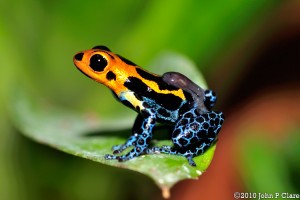In the world of frog communication, it has been demonstrated that visual signals provide important cues for recognizing conspecifics during both mate selection and aggressive territorial behaviors. In the case of similar-looking ‘doppelganger’ frog species, however, it is reasonable to expect that visual cues probably wouldn’t quite serve to distinguish between species so that other signals, like acoustic ones, all of a sudden become more important.
A recent study published in the Journal of Animal Behavior looks into territorial interactions with respect to acoustic signaling between two poison frog species that are phenotypically very similar and are considered to be Müllerian Mimics- this phenomenon occurs since over evolution, many aposematic animals have adopted similar appearances. This could be advantageous because they share the cost of educating their predators about their defenses (Stevens, 2013). But on the other hand, an inability to discriminate between species would lead to an increased waste of energetic costs. Therefore, it is important to understand how these species are able to distinguish their doppelgangers from their own kind.
Males of both species Ranitomeya imitator and Ranitomeya variabilis use calls for communicating with other species, but only Ranitomeya imitator from Amazonian Peru use calls to advertise and defend their territories from male intruders.
Though acoustic signals produced by males advertise information about their fitness, they are quite energetically costly. So to avoid wasting energy for territorial defense, the researchers hypothesized that R. imitator males should be able to discriminate between conspecifics and R.variabilis males by the structure of its call.
They addressed their interesting hypothesis by observing behavioral responses of R. imitator males to manipulated calls. Through playback field experiments in which they recorded and played calls of both frogs in different frequencies and temporal properties, they found that R. imitator is able to identify conspecifics on the basis of different call properties. Furthermore, they found that R. imitator does not use call length alone to discriminate its call from that of R. variabilis – they can actually recognize conspecific calls with wide variations in dominant frequency.
So apparently poison frogs are able to discriminate its own vocalizations from that of its mimic! How complex are the mechanisms behind all this? At this point, this question still remains unanswered. Nevertheless, this work provides more insight into animal communication and opens up the possibility that other modes of communication could be involved in species recognition.
Source:
Mayer, M., Schulte, L. M., Twomey, E., & Lötters, S. (2014). Do male poison frogs respond to modified calls of a Müllerian mimic ?, 89. doi:10.1016/j.anbehav.2013.12.013

